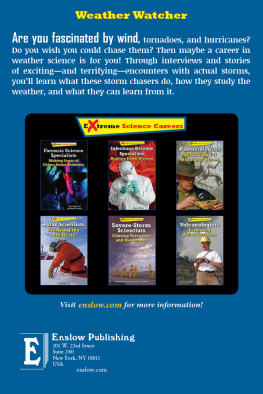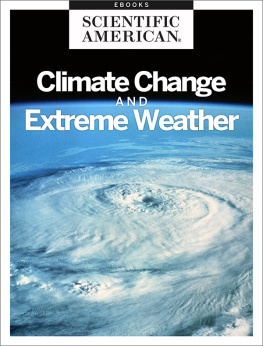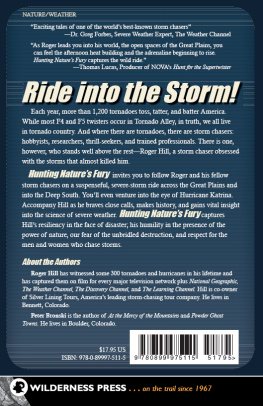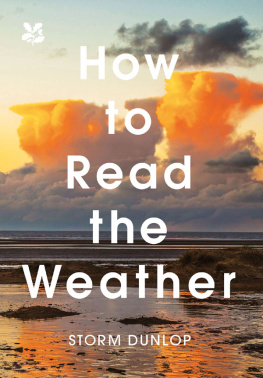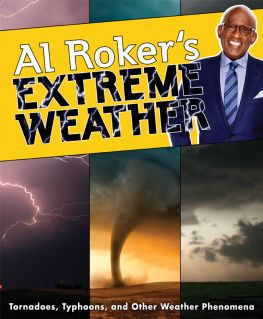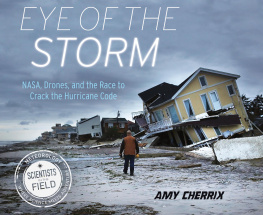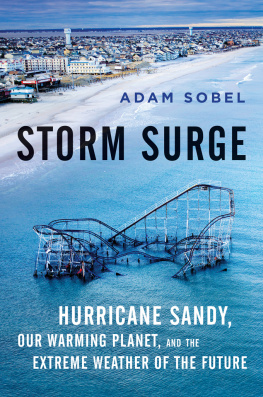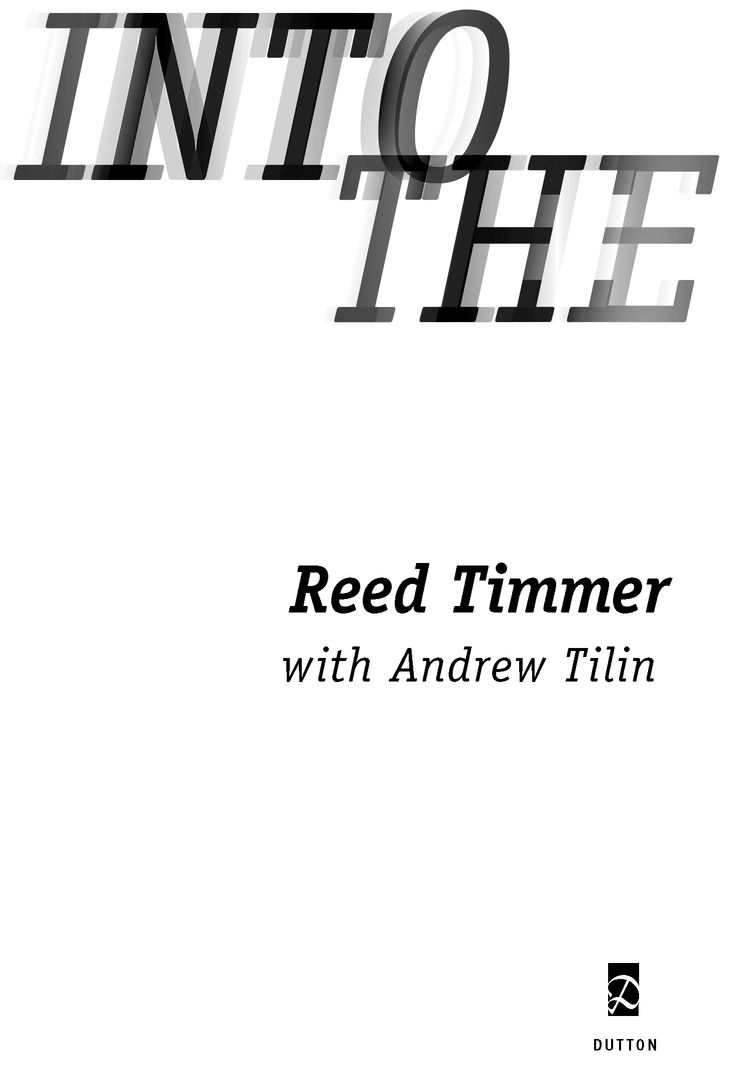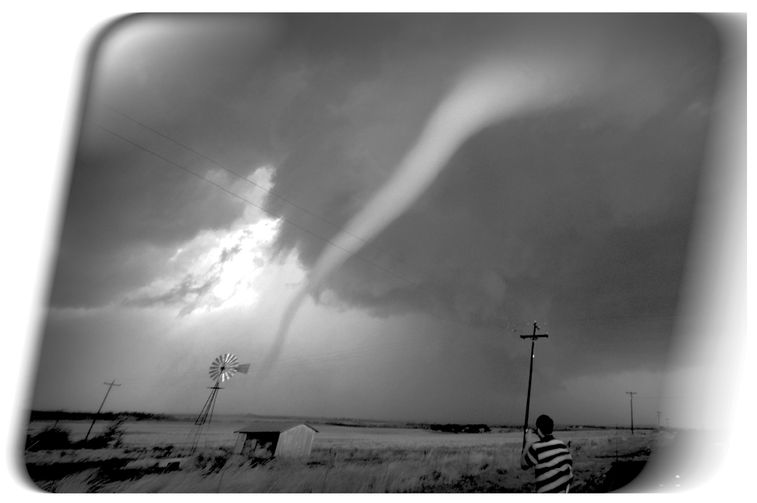Table of Contents
STORM
VIOLENT TORNADOES, KILLER HURRICANES,
AND DEATH-DEFYING ADVENTURES
IN EXTREME WEATHER
For my mom
INTRODUCTION:
STORM OF MY DREAMS
The dream starts with a breeze. When I envision the complex creation of the most violent and mysterious weather phenomenon of alla three-hundred-mile-per-hour, landscape-churning, damage-scale-topping tornadoit starts with a soothing breeze.
Here in central Oklahoma, where I really do live, and where tornadoes rated the maximum F5 on meteorologys Fujita Scale truly have gouged the earth time and time again, the breeze comes out of the south. The air is sultrymoist and warm. When it reaches your skin, its as thick as lotion, and it makes you feel like youve been transported somewhere exotic. You almost have. The breeze originates in the Gulf of Mexico, where it once washed over beachgoers.
In my mind, I watch how this special air flowsmeteorologists call this movement the low-level jetas if it were a river, a thousand feet in the sky, extending halfway across the continent to the Great Plains. When the tropical air reaches the likes of Texas, Oklahoma, Nebraska, or Kansas, something curious happens. And the air is no longer a quiet, soothing breeze.
Near the earths surface, moist air collides with different kinds of air coming from different directions. Hot, dry air from the American Southwest and northern Mexico. Cold air from the north, blown southward across Canada, all the way from the Arctic. Such a convergence doesnt happen everywhere, but in central Oklahoma its hardly a freak event. The Great Plainswhich weather nuts like me call Tornado Alleyis a rare, natural intersecting point for all this wind. About 90 percent of all tornadoes reported annually in the United Statessome eight hundred or more per yeartouch down in Tornado Alley.
In the birth of my envisioned F5, all of that clashing air follows a meteorological script. The hot, dry air injects the atmosphere with heat that serves as a springboard for the now warm, moist air to rise. As kids, we were taught that hot air riseshot air molecules agitate more than cold air molecules, and, needing lots of room to move, the hot air expands upward. When an F5 forms over Tornado Alley, this ascension is violent, sometimes moving at over one hundred miles per hour. The surrounding cold air only helps matters. Cold air forces neighboring hot air to rise faster.
Then, approximately a mile above the ground, the moisture in the rising air condenses into a mist. This is the meteorological equivalent of a shark fin popping out of the ocean water. It marks the beginnings of a storm cloud. Its the first visible sign of danger.
Usually the rising air in a cloud quickly cools as it ascends, and the cloud stops moving up. But not during the formation of an F5. The rising airthe updraftwont die. Condensation continues, and the traces of ascending mist accumulate, not unlike the way a snowball gathers more snow as it rolls downhill. But in the case of an F5, the snowball is climbing toward the heavens. On a humid spring day, folks in Tornado Alley can turn their backs on the sky for just minutes, to mow a lawn or wash a car. When they look up again, what was a cloud-free sky before has become blemishedmore like dominatedby a lone, sunlit, bright white, ominous cloud.
The crisp cloud in my mind rapidly grows from a height of hundreds to thousands to tens of thousands of feet, blasting through the troposphere and into the stratosphere until its thirteen miles tall. This is a cumulonimbus cloud, and in its most radical, towering form people say that it looks like the mushroom cloud thats associated with a nuclear explosion. Considering what an F5 tornado can do to both property and people, the metaphor isnt too far-fetched.
According to the Fujita Scale upon which the F5 classification is based, such a tornado can flatten homes, turn cars into airborne missiles, and debark trees. The Fujita Scale is a widely accepted damage scale for categorizing tornadoes thats based on the havoc they wreak, and F5 is used only to identify the most destructive rotating windsthose that spin anywhere from an estimated 261 to 318 miles per hour. Created by University of Chicago meteorologist Tetsuya Ted Fujita in 1971, the scales other five categories also use damage characteristics and estimated speeds to classify every other tornado: F0 (under 73 miles per hour); F1 (73 to 112 miles per hour); F2 (113 to 157 miles per hour); F3 (158 to 206 miles per hour); and F4 (207 to 260 miles per hour). In 2007, the F-scale was supplanted by a slightly modified Enhanced Fujita Scale, or EF-scale (for consistency Ive stuck with the F-scale, which was in use for most of my early days of storm chasing, throughout this book). Whichever scale you use, to suggest F5 is to suggest almost unfathomable power.
Sure enough, near the base of this imaginary and towering cumulonimbus cloud, forces are at work. Winds howl through the cloud at varying elevations, directions, and speeds. One gale from the southwest might blow at fifty miles per hour at an elevation of six thousand feet; another blows at sixty miles per hour, from the west and at ten thousand feet; a third gust maintains twenty miles per hour near the earths surface. This phenomenon is called wind shear. The conflicting and contrasting winds push and pull the air inside the cloud until, finally, that air moves in a uniform, circular current. Ultimately the air inside the cloud begins to rotate on a horizontal axis, much the same way that laundry rotates inside a clothes dryer.
The turbulence, however, has only just begun. The force of the updraft inside the cumulonimbus cloud acts like a crane, yanking and tilting the cylinder of rotating air inside the cloud as if it were a pipe that had to ultimately stand on one end. By the time the updraft inside the cloud is finished repositioning this cylinder of air, its now spinning vertically, like a barber pole.
Then the mesocyclone comes alive. I can picture it nowalthough anyone who is in the vicinity of such a cloud cant miss it. The mesocyclone, which is the rotating and rising air inside the cloud, is so powerful that it forces part, if not all, of the cloud to also turn. Theres more to the spectacle, too. Miles in the sky, the warm and moist air that fed the growth of the cumulonimbus cloud has finally cooled, causing an upper layer of ice crystals to spread in all directions like a pancake. Now that same guy who was washing his car might look up and see a massive, glistening, flying-saucer-shaped, rotating cloud. If I were him, and this storm were real, I wouldnt be turning my back on the sky anymore.
The rogue cloud structure is now known as a supercell thunderstorm. Pregnant with moisture, wind, and both the warm air coming in and the cooling air spewing out its top and trickling down, the storm roars forth. Thunder. Lightning. Torrential rain. Cold cloud droplets turn into hail and get swept back into the updraft, only to attract more moisture and freeze again, cycling through until the hailstones grow as big as baseballs. Then they finally fall from the sky, kill livestock, smash windshields, and put holes in the roofs of buildings.


